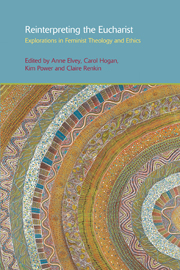Book contents
- Frontmatter
- Contents
- List of Illustrations
- Foreword
- Acknowledgements
- Contributors
- 1 Introduction
- 2 Eucharistic Metamorphosis: Changing Symbol, Changing Lives
- 3 The Sunday Eucharist: Embodying Christ in a Prophetic Act
- 4 How Australian Aboriginal Christian Womanist Tiddas (Sisters) Theologians Celebrate the Eucharist
- 5 Women, Eucharist, and Good News to All Creation in Mark
- 6 Rediscovering Forgotten Features: Scripture, Tradition and Whose Feet May Be Washed on Holy Thursday Night
- 7 Mystery Appropriated: Disembodied Eucharist and Meta-theology
- 8 Real Presence: Seeing, Touching, Tasting: Visualizing the Eucharist in Late Medieval Art
- 9 Embodying the Eucharist
- 10 Living One for the Other: Eucharistic Hospitality as Ecological Hospitality
- Subject Index
- Name Index
9 - Embodying the Eucharist
- Frontmatter
- Contents
- List of Illustrations
- Foreword
- Acknowledgements
- Contributors
- 1 Introduction
- 2 Eucharistic Metamorphosis: Changing Symbol, Changing Lives
- 3 The Sunday Eucharist: Embodying Christ in a Prophetic Act
- 4 How Australian Aboriginal Christian Womanist Tiddas (Sisters) Theologians Celebrate the Eucharist
- 5 Women, Eucharist, and Good News to All Creation in Mark
- 6 Rediscovering Forgotten Features: Scripture, Tradition and Whose Feet May Be Washed on Holy Thursday Night
- 7 Mystery Appropriated: Disembodied Eucharist and Meta-theology
- 8 Real Presence: Seeing, Touching, Tasting: Visualizing the Eucharist in Late Medieval Art
- 9 Embodying the Eucharist
- 10 Living One for the Other: Eucharistic Hospitality as Ecological Hospitality
- Subject Index
- Name Index
Summary
Part I: Introducing the Christa
Since the earliest days of the church, childbirth has been used as a metaphor for Eucharist. In Christ's farewell discourse at the Last Supper (Jn 16.21 cf. 19.24), Christ's coming passion, death and resurrection are compared to a woman giving birth, thereby placing Christ in the prophetic tradition that compared the coming of the Kingdom (and also the Day of the Lord) to a woman in labour (Isa. 42.12–16, 66.7–14; Jer. 50.43–46; Mic. 5.3; Hos. 13.11–14; gal. 4.19–20; Mt. 24.7–8; Jn 3.1–8). This is in keeping with Job's use of childbirth as a metaphor for Creation (Job 38.8). Indeed, this metaphor is over determined as revelatory of the sacred, for the prophets also compared God's election of Israel, and later, God's suffering in bringing Israel to conversion, to a woman giving birth and then carrying her babe through the desert (Jer. 6.24b; cf. 30.21; Isa. 42.14, esp. 42.3, 66.13). The early Church Fathers maintained this tradition as the foundation for their eucharistic theology. For them, when Christ's side gushed with the fluids of birthing—blood and water—then Genesis was recapitulated as Christ gave birth to a redeemed creation, simultaneously creating and inseminating his Bride, the Church. In this dispensation Jesus becomes the New Adam and Mary, the New Eve, through whom Adam and Eve's sin is graciously redeemed. This conflation of Eucharist and Baptism meant that childbirth was also the privileged metaphor for Baptism (Jn 3.1–8; Tit. 3.5). This tells us something about the nature of divine reality—creation is accomplished through suffering that ultimately brings its own ecstatic joys.
- Type
- Chapter
- Information
- Reinterpreting the EucharistExplorations in Feminist Theology and Ethics, pp. 152 - 185Publisher: Acumen PublishingPrint publication year: 2012



